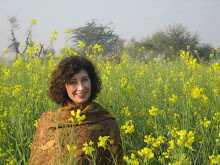 During a recent trip to Soor Sarvora bird sanctuary in Agra I came upon the Sloth Bear Rescue, a program supported by the non-profit Wildlife S.O.S of India. The preserve was closed to visitors without a reservation, but a guard kindly summoned one of the resident biologists who gave me a tour of the facility.
During a recent trip to Soor Sarvora bird sanctuary in Agra I came upon the Sloth Bear Rescue, a program supported by the non-profit Wildlife S.O.S of India. The preserve was closed to visitors without a reservation, but a guard kindly summoned one of the resident biologists who gave me a tour of the facility.Just inside the park, a furry sloth bear lumbered up to the chain-link fence of the enclosure and sniffed. "They're each given new names when they arrive at the sanctuary," the biologist said. All of the bears in the park have been rescued from miserable lives as dancing bears.
For generations, Kalandar gypsy tribes have captured young bears soon after birth, often killing the mother in the process. The bears are then trained to "dance" for entertainment, tourists, and photo opportunities. The process to convert them to lives in captivity is brutal. Their teeth are pulled, claws chopped off and sensitive muzzles pierced for ropes just 4 feet in length. It was two years ago I saw a billboard admonishing, "Just Say No to Dancing Bears" with a picture of a sloth bear performing. This public education is essential.
The good news is the efforts of this organization have resulted in more that 480 rescued and rehabilitated bears since 2002. Through the program, "owners" are paid $1,000 to peacefully surrender the bear and are also given $1,000 worth of training and educational opportunities for themselves and their families.
Individuals are trained in areas such as driving, welding, tailoring, embroidery, and helping to set up shops and small businesses. The group also provides accessible education for children and health care clinics.
Sloth Bear Rescue has opened several sanctuaries in India and continues to conserve and protect the species by acquiring land, protecting habitat and curtailing poaching. For $45 a month, you can sponsor a bear where they are free to roam, play, interact with other bears and live life in a safe environment.











